Portal maintenance status: (July 2022)
|
The Hotels Portal

A hotel is an establishment that provides paid lodging on a short-term basis. Facilities provided inside a hotel room may range from a modest-quality mattress in a small room to large suites with bigger, higher-quality beds, a dresser, a refrigerator, and other kitchen facilities, upholstered chairs, a flat-screen television, and en-suite bathrooms. Small, lower-priced hotels may offer only the most basic guest services and facilities. Larger, higher-priced hotels may provide additional guest facilities such as a swimming pool, a business center with computers, printers, and other office equipment, childcare, conference and event facilities, tennis or basketball courts, gymnasium, restaurants, day spa, and social function services. Hotel rooms are usually numbered (or named in some smaller hotels and B&Bs) to allow guests to identify their room. Some boutique, high-end hotels have custom decorated rooms. Some hotels offer meals as part of a room and board arrangement. In Japan, capsule hotels provide a tiny room suitable only for sleeping and shared bathroom facilities.
Hotel operations vary in size, function, complexity, and cost. Most hotels and major hospitality companies have set industry standards to classify hotel types. An upscale full-service hotel facility offers luxury amenities, full-service accommodations, an on-site restaurant, and the highest level of personalized service, such as a concierge, room service, and clothes-ironing staff. Full-service hotels often contain upscale full-service facilities with many full-service accommodations, an on-site full-service restaurant, and a variety of on-site amenities. Boutique hotels are smaller independent, non-branded hotels that often contain upscale facilities. Small to medium-sized hotel establishments offer a limited amount of on-site amenities. Economy hotels are small to medium-sized hotel establishments that offer basic accommodations with little to no services. Extended stay hotels are small to medium-sized hotels that offer longer-term full-service accommodations compared to a traditional hotel. (Full article...)
Recognized articles -
 Image 1
Image 1
The Dorchester is a five-star hotel located on Park Lane and Deanery Street in London, to the east of Hyde Park. It is one of the world's most prestigious hotels. The Dorchester opened on 18 April 1931, and it still retains its 1930s furnishings and ambiance despite being modernised.
Throughout its history, the hotel has been closely associated with the rich and famous. During the 1930s, it became known as a haunt of numerous writers and artists such as poet Cecil Day-Lewis, novelist Somerset Maugham, and the painter Sir Alfred Munnings. It has held prestigious literary gatherings, such as the "Foyles Literary Luncheons", an event the hotel still hosts today. During the Second World War, the strength of its construction gave the hotel the reputation of being one of London's safest buildings, and notable members of political parties and the military chose it as their London residence. Queen Elizabeth II attended the Dorchester when she was a princess on the day prior to the announcement of her engagement to Philip Mountbatten on 10 July 1947. The hotel has since become particularly popular with film actors, models and rock stars, and Elizabeth Taylor and Richard Burton frequently stayed at the hotel throughout the 1960s and 1970s. The hotel became a Grade II Listed Building in January 1981, and was subsequently purchased by the Sultan of Brunei in 1985. It belongs to the Dorchester Collection, which in turn is owned by the Brunei Investment Agency (BIA), an arm of the Ministry of Finance of Brunei. (Full article...) Image 2
Image 2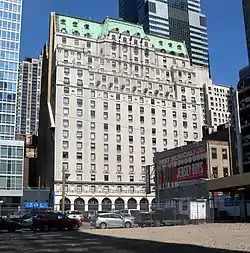
The Paramount Hotel (formerly the Century-Paramount Hotel) is a hotel in the Theater District of Midtown Manhattan in New York City, United States. Designed by architect Thomas W. Lamb, the hotel is at 235 West 46th Street, between Eighth Avenue and Broadway. The Paramount Hotel is owned by RFR Realty and contains 597 rooms. The hotel building, designed in a Renaissance style, is a New York City designated landmark.
The hotel is 19 stories tall and is H-shaped in arrangement, with light courts to the west and east. The north and south faces of the hotel contain numerous setbacks. The facade is made of brick, stone, and terracotta; most of the decorative detail is concentrated on the south facade, along 46th Street. The hotel building contains a double-height colonnade at street level, as well as several terraces above each of the setbacks. The building has a double-height hip roof flanked by mansard roofs. The basement contains an event venue named Sony Hall, which has historically been used as a nightclub and theater. The double-height lobby's design dates to a 1990 renovation by Philippe Starck. (Full article...) Image 3The Briarcliff Lodge was a luxury resort in the village of Briarcliff Manor, New York. It was a notable example of Tudor Revival architecture, and was one of the largest wooden structures in the United States. It was also the first hotel in Westchester County. Walter William Law had it built on his estate, and the Law family owned it until 1937. When the lodge opened in 1902, it was one of the largest resort hotels in the world. The lodge hosted presidents, royalty, and celebrities, and was the scene of numerous memorable occasions for visitors and local residents who attended weddings, receptions, and dances in the ballroom and dining room. For a long time, the lodge was situated among other businesses of Walter Law, including the Briarcliff Farms and Briarcliff Table Water Company.
Image 3The Briarcliff Lodge was a luxury resort in the village of Briarcliff Manor, New York. It was a notable example of Tudor Revival architecture, and was one of the largest wooden structures in the United States. It was also the first hotel in Westchester County. Walter William Law had it built on his estate, and the Law family owned it until 1937. When the lodge opened in 1902, it was one of the largest resort hotels in the world. The lodge hosted presidents, royalty, and celebrities, and was the scene of numerous memorable occasions for visitors and local residents who attended weddings, receptions, and dances in the ballroom and dining room. For a long time, the lodge was situated among other businesses of Walter Law, including the Briarcliff Farms and Briarcliff Table Water Company.
In 1933, the lodge ended year-round service and housed a "health-diet sanitarium" until the Edgewood Park School for Girls began operation there from 1937 to 1954. From 1936 to 1939, the lodge was run again as a hotel in the summer months while the school was closed. From 1955 to 1994, The King's College used the lodge building and built dormitories and academic buildings. Abandoned and unmaintained after 1994, the Briarcliff Lodge was destroyed between 2003 and 2004. (Full article...) Image 4
Image 4 The Ryugyong Hotel in May 2012
The Ryugyong Hotel in May 2012
The Ryugyong Hotel (Korean: 류경호텔; sometimes spelled as Ryu-Gyong Hotel), or Yu-Kyung Hotel, is an unfinished, topped-out 330-metre-tall (1,080 ft) pyramid-shaped skyscraper in Pyongyang, North Korea. It is colloquially referred to as the "Hotel of Doom" by outsiders. Its name ("capital of willows," 柳京 in Hanja) is also one of the historical names for Pyongyang. The building has been planned as a mixed-use development, which would include a hotel.
Construction began in 1987 but was halted in 1992 as North Korea entered a period of economic crisis after the dissolution of the Soviet Union. After 1992, the building stood topped out, but without any windows or interior fittings. In 2008, construction resumed, and the exterior was completed in 2011. The hotel was planned to open in 2012, the centenary of founding leader Kim Il Sung's birth. A partial opening was announced for 2013, but this was cancelled. In 2018, an LED display was fitted to one side, which is used to show propaganda animations and film scenes. (Full article...) Image 5
Image 5 The George Hotel, Crawley
The George Hotel, Crawley
The George Hotel, also known as the George Inn and now marketed as the Ramada Crawley Gatwick, is a hotel and former coaching inn on the High Street in Crawley, a town and borough in West Sussex, England. The George was one of the country's most famous and successful coaching inns, and the most important in Sussex, because of its location halfway between the capital city, London, and the fashionable seaside resort of Brighton. Cited as "Crawley's most celebrated building", it has Grade II* listed status.
It is known that a building called the George has existed on the site since the 16th century or earlier, and many sources date the core of the existing inn to 1615. The George Hotel has three principal sections, facing east and running from south to north parallel with Crawley High Street. Nothing of the exterior is original, except perhaps for parts of the tiled roof. The hotel contains 84 rooms and 6 meeting rooms with a capacity of up to 150, regularly used for conferences, weddings, exhibitions, seminars and training sessions. The present structure is made up of disparate parts of various dates: the inn expanded to take in adjacent buildings as its success grew in the 18th and 19th centuries. Major changes took place in the 1930s, and the annex was knocked down in 1933. (Full article...) Image 6
Image 6 Engraved vignettes of the original hotels c. 1915
Engraved vignettes of the original hotels c. 1915
The Waldorf-Astoria originated as two hotels, built side by side by feuding relatives, on Fifth Avenue in New York, New York, United States. Built in 1893 and expanded in 1897, the hotels were razed in 1929 to make way for construction of the Empire State Building. Their successor, the current Waldorf Astoria New York, was built on Park Avenue in 1931.
The original Waldorf Hotel opened on March 13, 1893, at the corner of Fifth Avenue and 33rd Street, on the site where millionaire developer William Waldorf Astor had previously built his mansion. Constructed in the German Renaissance style by Henry Janeway Hardenbergh, it stood 225 feet (69 m) high, with fifteen public rooms and 450 guest rooms, and a further 100 rooms allocated to servants, with laundry facilities on the upper floors. It was heavily furnished with antiques purchased by founding manager and president George Boldt and his wife during an 1892 visit to Europe. The Empire Room was the largest and most lavishly adorned room in the Waldorf, and soon after opening it became one of the best restaurants in New York, rivaling Delmonico's and Sherry's. (Full article...) Image 7
Image 7 The Hotel Europa in Maracaibo, c. 1897
The Hotel Europa in Maracaibo, c. 1897
The Hotel Europa was a grand hotel located in Maracaibo, Venezuela. It opened in the late 19th century and served as the filming location for the first Venezuelan film, Un célebre especialista sacando muelas en el gran Hotel Europa, in 1897. Later, it was converted into other hotels with different names, most notably the Hotel Zulia, before being demolished in 1956 for the construction of the Maracaibo municipal building. (Full article...) Image 8
Image 8 Seen from the corner of 5th Ave. and 58th St.
Seen from the corner of 5th Ave. and 58th St.
The Plaza Hotel (also known as The Plaza) is a luxury hotel and condominium apartment building in Midtown Manhattan in New York City. It is located on the western side of Grand Army Plaza, after which it is named, just west of Fifth Avenue, and is between 58th Street and Central Park South (a.k.a. 59th Street), at the southeastern corner of Central Park. Its primary address is 768 Fifth Avenue, though the residential entrance is One Central Park South.
The 18-story, French Renaissance-inspired château style building was designed by Henry Janeway Hardenbergh. The facade is made of marble at the base, with white brick covering the upper stories, and is topped by a mansard roof. The ground floor contains the two primary lobbies, as well as a corridor connecting the large ground-floor restaurant spaces, including the Oak Room, the Oak Bar, the Edwardian Room, the Palm Court, and the Terrace Room. The upper stories contain the ballroom and a variety of residential condominiums, condo-hotel suites, and short-term hotel suites. At its peak, the Plaza Hotel had over 800 rooms. Following a renovation in 2008, the building has 282 hotel rooms and 181 condos. (Full article...) Image 9
Image 9.jpg.webp) Seen from across Broadway and 42nd Street, 2021
Seen from across Broadway and 42nd Street, 2021
The Knickerbocker Hotel is a hotel at Times Square, on the southeastern corner of Broadway and 42nd Street, in the Midtown Manhattan neighborhood of New York City. Built by John Jacob Astor IV, the hostelry was designed in 1901 and opened in 1906. Its location near the Theater District around Times Square was intended to attract not only residential guests but also theater visitors.
The Knickerbocker Hotel is largely designed in the Beaux-Arts style by Marvin & Davis, with Bruce Price as consultant. Its primary frontages are on Broadway and 42nd Street. These facades are constructed of red brick with terracotta details and a prominent mansard roof. The Knickerbocker Hotel also incorporates an annex on 41st Street, built in 1894 as part of the St. Cloud Hotel, which formerly occupied the site. The 41st Street facade contains a Romanesque Revival design by Philip C. Brown. Inside, the hotel contains 300 rooms, a restaurant, a coffee shop, and a roof bar. The original interior design was devised in 1905 by Trowbridge & Livingston. There are scattered remnants of the original interior design, including an entrance that formerly led from the New York City Subway's Times Square station to the hotel's basement. (Full article...) Image 10Claudius Charles Philippe, also known as Philippe of the Waldorf or The Host of the Waldorf, (10 December 1910—24 December 1978) was a British-born French-American restaurateur, catering director, hotelier and businessman, who was the hotel banquet manager of the prestigious Waldorf Astoria New York hotel in the 1940s and 1950s. From 1961 until 1963 he worked as executive vice president of Loews Hotels, and was responsible for the planning and building of six new New York hotels.
Image 10Claudius Charles Philippe, also known as Philippe of the Waldorf or The Host of the Waldorf, (10 December 1910—24 December 1978) was a British-born French-American restaurateur, catering director, hotelier and businessman, who was the hotel banquet manager of the prestigious Waldorf Astoria New York hotel in the 1940s and 1950s. From 1961 until 1963 he worked as executive vice president of Loews Hotels, and was responsible for the planning and building of six new New York hotels.
Philippe is best remembered for founding the April in Paris Ball at the Waldorf Astoria in 1951, which he ran with Elsa Maxwell until his sacking from the hotel in 1959. The balls were major events in the US socialite calendar, and raised millions of dollars for American and French charities over the 28 years of its existence. His Lucullus Circle dinners also attracted some of the wealthiest businessmen of the day to feast on six to eight course meals. During his career at the Waldorf Astoria it has been estimated that Philippe was responsible for his clients spending $150 million alone on banquets, which led him to be referred to as "one of the truly great men this industry has ever produced" by George Lang. (Full article...) Image 11The Hotel Polen fire occurred on 9 May 1977 in Amsterdam, the Netherlands. The conflagration destroyed the Hotel Polen (Hotel Poland), a five-story hotel in the centre of the city which had been built in 1891, as well as the furniture store on the ground level and a nearby bookstore. Many of the tourists staying at the hotel (of whom the majority were Swedes) jumped to their deaths trying to escape the flames. Upon their arrival, the fire department used a life net to help people escape, but not everyone could be saved. The incident resulted in 33 deaths and 21 severe injuries. The cause of the fire is unknown. In 1986 the Polish-born artist Ania Bien created a photographic installation based on the fire which compared it to the Holocaust.
Image 11The Hotel Polen fire occurred on 9 May 1977 in Amsterdam, the Netherlands. The conflagration destroyed the Hotel Polen (Hotel Poland), a five-story hotel in the centre of the city which had been built in 1891, as well as the furniture store on the ground level and a nearby bookstore. Many of the tourists staying at the hotel (of whom the majority were Swedes) jumped to their deaths trying to escape the flames. Upon their arrival, the fire department used a life net to help people escape, but not everyone could be saved. The incident resulted in 33 deaths and 21 severe injuries. The cause of the fire is unknown. In 1986 the Polish-born artist Ania Bien created a photographic installation based on the fire which compared it to the Holocaust.
The hotel was located between the Kalverstraat (no. 15–17) and the Rokin (no. 14), near the present day Madame Tussauds. Its place is now occupied by the Rokin Plaza, originally an office building, which today houses several fashion shops. (Full article...)![Image 12Richard D'Oyly CarteRichard D'Oyly Carte ([ˈdɔɪli kɑːt]; 3 May 1844 – 3 April 1901) was an English talent agent, theatrical impresario, composer, and hotelier during the latter half of the Victorian era. He built two of London's theatres and a hotel empire, while also establishing an opera company that ran continuously for over a hundred years and a management agency representing some of the most important artists of the day.Carte started his career working for his father, Richard Carte, in the music publishing and musical instrument manufacturing business. As a young man he conducted and composed music, but he soon turned to promoting the entertainment careers of others through his management agency. Carte believed that a school of wholesome, well-crafted, family-friendly, English comic opera could be as popular as the risqué French works dominating the London musical stage in the 1870s. To that end he brought together the dramatist W. S. Gilbert and composer Arthur Sullivan and nurtured their collaboration on a series of thirteen Savoy operas. He founded the D'Oyly Carte Opera Company and built the state-of-the-art Savoy Theatre to host the Gilbert and Sullivan operas. (Full article...)](../I/Blank.png.webp) Image 12
Image 12 Richard D'Oyly Carte
Richard D'Oyly Carte
Richard D'Oyly Carte ([ˈdɔɪli kɑːt]; 3 May 1844 – 3 April 1901) was an English talent agent, theatrical impresario, composer, and hotelier during the latter half of the Victorian era. He built two of London's theatres and a hotel empire, while also establishing an opera company that ran continuously for over a hundred years and a management agency representing some of the most important artists of the day.
Carte started his career working for his father, Richard Carte, in the music publishing and musical instrument manufacturing business. As a young man he conducted and composed music, but he soon turned to promoting the entertainment careers of others through his management agency. Carte believed that a school of wholesome, well-crafted, family-friendly, English comic opera could be as popular as the risqué French works dominating the London musical stage in the 1870s. To that end he brought together the dramatist W. S. Gilbert and composer Arthur Sullivan and nurtured their collaboration on a series of thirteen Savoy operas. He founded the D'Oyly Carte Opera Company and built the state-of-the-art Savoy Theatre to host the Gilbert and Sullivan operas. (Full article...) Image 13
Image 13
The Manila Hotel is a 550-room, historic five-star hotel located along Manila Bay in Manila, Philippines. The hotel is the oldest premiere hotel in the Philippines built in 1909 to rival Malacañang Palace, the official residence of the President of the Philippines and was opened on the commemoration of American Independence on July 4, 1912. The hotel complex was built on a reclaimed area of 35,000 square metres (380,000 sq ft) at the northwestern end of Rizal Park along Bonifacio Drive in Ermita. Its penthouse served as the residence of General Douglas MacArthur during his tenure as the Military Advisor of the Philippine Commonwealth from 1935 to 1941.
The hotel used to host the offices of several foreign news organizations, including The New York Times. It has hosted world leaders and celebrities, including authors Ernest Hemingway and James A. Michener; actors Douglas Fairbanks, Jr. and John Wayne; publisher Henry Luce; entertainers Sammy Davis, Jr., Michael Jackson and The Beatles; and U.S. President Bill Clinton. (Full article...) Image 14
Image 14 Looking east across L'Enfant Plaza at the Hilton Washington DC National Mall
Looking east across L'Enfant Plaza at the Hilton Washington DC National Mall
The Hilton Washington DC National Mall The Wharf, previously known as the L'Enfant Plaza Hotel, is a 367-room hotel located on the top four floors of a 12-story mixed-use building in downtown Washington, D.C., in the United States. It was designed by architect Vlastimil Koubek, and was opened on May 31, 1973, as the Loews L'Enfant Plaza Hotel, named after Pierre Charles L'Enfant, the first surveyor and designer of the street layout of the city.
The hotel sits atop L'Enfant Plaza, an esplanade and plaza structure erected above a highway and a parking garage in the Southwest quadrant of the District of Columbia. The plaza and hotel were approved in 1955, but construction did not begin on the plaza (on which the hotel sits) until 1965. The plaza and esplanade were completed in 1968. The start of construction on the hotel was delayed three years, and was completed in May 1973. The construction led to a lawsuit after it was found that the foundation of an adjoining structure had encroached on the hotel's property. The hotel suffered a serious fire in 1975 that claimed the lives of two people. (Full article...) Image 15
Image 15 The Crown at Whitebrook in 2008
The Crown at Whitebrook in 2008
The Whitebrook, formerly known as The Crown at Whitebrook, is a restaurant with rooms in Whitebrook, 6 miles (9.7 km) south-south-east of Monmouth, Monmouthshire, Wales, near the River Wye and the border with England. The building is thought to date from the 17th century and by the 19th century it was used as a roadside inn. Its restaurant was run by Chef Patron James Sommerin until 2013; it gained a Michelin star in 2007. It contains eight double rooms and a 2-acre (0.81 ha) garden. On 7 March 2013, it closed because of financial difficulties; at the time it had the longest held Michelin star in Wales. Critics praised the food under Sommerin, but have criticised the difficulty in finding the restaurant. It re-opened in October 2013 under new chef and owner Chris Harrod, and regained the Michelin star in 2014. Harrod serves a menu using locally produced meat and vegetables along with foraged ingredients such as charlock, hedge bedstraw and pennywort. (Full article...)
General images -
 Image 1The Peninsula New York hotel, located at the corner of Fifth Avenue and 55th Street in Midtown Manhattan (from Hotel)
Image 1The Peninsula New York hotel, located at the corner of Fifth Avenue and 55th Street in Midtown Manhattan (from Hotel) Image 2The Waldorf Astoria New York, the most expensive hotel ever sold, cost US$1.95 billion in 2014. (from Hotel)
Image 2The Waldorf Astoria New York, the most expensive hotel ever sold, cost US$1.95 billion in 2014. (from Hotel)
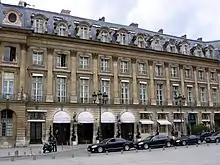
.jpg.webp)
 Image 6Abandoned Grand West Courts in Chicago (from Motel)
Image 6Abandoned Grand West Courts in Chicago (from Motel)

 Image 9Ithaa, the first undersea restaurant at the Conrad Maldives Rangali Island resort (from Hotel)
Image 9Ithaa, the first undersea restaurant at the Conrad Maldives Rangali Island resort (from Hotel) Image 10The Harrison Hotel, an SRO hotel in Oakland, California. (from Apartment hotel)
Image 10The Harrison Hotel, an SRO hotel in Oakland, California. (from Apartment hotel) Image 11Burj Al Arab stands on an artificial island from Jumeirah Beach and is connected to the mainland by a private curving bridge. (from Hotel)
Image 11Burj Al Arab stands on an artificial island from Jumeirah Beach and is connected to the mainland by a private curving bridge. (from Hotel) Image 12Railroad Park Resort, a Caboose Hotel in Northern California (from Hotel)
Image 12Railroad Park Resort, a Caboose Hotel in Northern California (from Hotel)



 Image 17Wigwam Motel No. 6, a unique motel/motor court on historic Route 66 in Holbrook, Arizona (from Motel)
Image 17Wigwam Motel No. 6, a unique motel/motor court on historic Route 66 in Holbrook, Arizona (from Motel).jpg.webp)

_(cropped).jpg.webp) Image 20The Boody House Hotel in Toledo, Ohio (from Hotel)
Image 20The Boody House Hotel in Toledo, Ohio (from Hotel)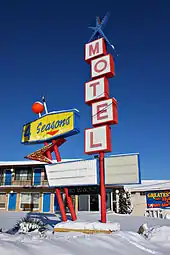 Image 21The 4 Seasons Motel sign in Wisconsin Dells, Wisconsin is an excellent example of googie architecture (from Motel)
Image 21The 4 Seasons Motel sign in Wisconsin Dells, Wisconsin is an excellent example of googie architecture (from Motel) Image 22Sign on Chicago motel (from Motel)
Image 22Sign on Chicago motel (from Motel)
 Image 24On top of the cliff, the Riosol Hotel in Mogán (from Hotel)
Image 24On top of the cliff, the Riosol Hotel in Mogán (from Hotel)

 Image 27Holiday Inn's "Great Sign", used until 1982. Some remain in museums. (from Motel)
Image 27Holiday Inn's "Great Sign", used until 1982. Some remain in museums. (from Motel) Image 28Motels frequently have large pools, such as the Thunderbird Motel on the Columbia River in Portland, Oregon (1973) (from Motel)
Image 28Motels frequently have large pools, such as the Thunderbird Motel on the Columbia River in Portland, Oregon (1973) (from Motel) Image 29A typical hotel room with a bed, desk, and television (from Hotel)
Image 29A typical hotel room with a bed, desk, and television (from Hotel)


 Image 33Ice Hotel in Jukkasjärvi, Sweden (from Hotel)
Image 33Ice Hotel in Jukkasjärvi, Sweden (from Hotel) Image 34An apartment hotel in Hammond, Indiana (from Apartment hotel)
Image 34An apartment hotel in Hammond, Indiana (from Apartment hotel) Image 35The Star Lite Motel in Dilworth, Minnesota is a typical American 1950s L-shaped motel (from Motel)
Image 35The Star Lite Motel in Dilworth, Minnesota is a typical American 1950s L-shaped motel (from Motel)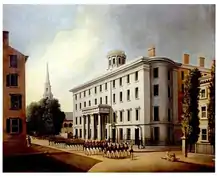 Image 36Tremont House in Boston, United States, a luxury hotel, the first to provide indoor plumbing (from Hotel)
Image 36Tremont House in Boston, United States, a luxury hotel, the first to provide indoor plumbing (from Hotel)
Selected articles -
 Image 1
Image 1 Breakfast Creek Hotel in 2008, the lights of Allan Border Field in the background
Breakfast Creek Hotel in 2008, the lights of Allan Border Field in the background
Breakfast Creek Hotel is a heritage-listed hotel at 2 Kingsford Smith Drive, Albion, City of Brisbane, Queensland, Australia. It was designed by Simkin & Ibler and built in 1889 to 1890 by Thomas Woollam & William Norman. It was added to the Queensland Heritage Register on 21 October 1992.
Standing completely detached in its own grounds, it was designed in the French Renaissance architecture style. The centre portion is recessed with a loggia of four arches, paved with Encaustic tiles. On the left wing, the bar entrance has a pediment flanked by Doric pilasters. The right wing contained the commercial and drawing-rooms and was finished with a two-storied bay-window. A massive cornice, with parapets and pediments, covers the front, left and right sides of the building. On the roof, each wing is capped with a pavilion having bevelled-corners and crowned with an ornamental iron cresting and tall flag-poles. Externally the walls are tuck-pointed with rusticated quoins at the angles.
William McNaughton Galloway's initials and the date appear on the front facade of the hotel. (Full article...) Image 2
Image 2.JPG.webp) The fourth incarnation of the International Hotel
The fourth incarnation of the International Hotel
The International Hotel, often referred to locally as the I-Hotel, was a low-income single-room-occupancy residential hotel in San Francisco, California's Manilatown. It was home to many Asian Americans, specifically a large Filipino American population. Around 1954, the I-Hotel also famously housed in its basement Enrico Banduccci's original "hungry i" nightclub. During the late 60s, real estate corporations proposed plans to demolish the hotel, which would necessitate displacing all of the I-Hotel's elderly tenants.
In response, housing activists, students, community members, and tenants united to protest and resist eviction. All the tenants were evicted on August 4, 1977 and the hotel was demolished in 1981. After the site was purchased by the International Hotel Senior Housing Inc., it was rebuilt and opened in 2005. It now shares spaces with St. Mary's School and Manilatown Center. (Full article...) Image 3Djurdje S. Ninković (1888–1940) was a prominent businessman and hotelier in Belgrade, Kingdom of Yugoslavia, in the 1920s and 1930s. At that time Belgrade had very few hotels and Ninković was a pioneer in establishing functional style affordable hotels specifically aimed at business people. (Full article...)
Image 3Djurdje S. Ninković (1888–1940) was a prominent businessman and hotelier in Belgrade, Kingdom of Yugoslavia, in the 1920s and 1930s. At that time Belgrade had very few hotels and Ninković was a pioneer in establishing functional style affordable hotels specifically aimed at business people. (Full article...) Image 4
Image 4
Georges Panayotis (Georges Panayotis is a pseudonym for Georges Chatzipanayotis) is a French/Greek businessman and consultant for the tourism, hotel and hospitality industries. He has contributed to establishing more than 2,500 hotels (150,000 hotel rooms) in France and throughout EMEA, representing a global investment of over 10.5 billion euros. (Full article...) Image 5The Nevele Grande Hotel (NEV-uh-lee) was a high rise resort hotel located in Wawarsing, New York, United States, just outside Ellenville, New York; it closed in 2009. The Nevele dated back to the days of the Borscht Belt, opening in 1901. “Nevele” is “Eleven” spelled backwards — according to lore, after the eleven nineteenth-century schoolteachers who discovered a waterfall within the present-day property. And according to family lore, the founder Charles Slutsky had had eleven children from 1880-1906 and the name might have come from that instead.
Image 5The Nevele Grande Hotel (NEV-uh-lee) was a high rise resort hotel located in Wawarsing, New York, United States, just outside Ellenville, New York; it closed in 2009. The Nevele dated back to the days of the Borscht Belt, opening in 1901. “Nevele” is “Eleven” spelled backwards — according to lore, after the eleven nineteenth-century schoolteachers who discovered a waterfall within the present-day property. And according to family lore, the founder Charles Slutsky had had eleven children from 1880-1906 and the name might have come from that instead.
The hotel closed in 2009. A June 2020 report indicated that the "buildings remain, falling apart and with no future of reuse ... there are plans to tear down the remaining structures on the property and turn it into a sports complex". The property included a once highly regarded 18-hole golf course and a 9-hole golf course which are closed and have fallen into disrepair. (Full article...) Image 6
Image 6 Room service with empanadas at Boon Hotel + Spa in Guerneville, California.
Room service with empanadas at Boon Hotel + Spa in Guerneville, California.
Room service or in-room dining is a hotel service enabling guests to choose items of food and drink for delivery to their hotel room for consumption. Room service is organized as a subdivision within the food and beverage department of high-end hotel and resort properties. It is uncommon for room service to be offered in hotels that are not high-end, or in motels. Room service may also be provided for guests on cruise ships. Room service may be provided on a 24-hour basis or limited to late night hours only. Due to the cost of customized orders and delivery of room service, prices charged to the patron are typically much higher than in the hotel's restaurant or tuck shop, and a gratuity is expected in some regions. (Full article...) Image 7
Image 7 Location in California
Location in California
The Madonna Inn is a motel in San Luis Obispo, California. Opened for business in 1958, it quickly became a landmark on the Central Coast of California. It is noted for its unique decor, pink dining room, and themed rooms. It was created by Alex Madonna, a successful construction magnate and entrepreneur (d. April 2004), and his wife Phyllis. The inn includes a restaurant and bakery, and is located on the west side of US Route 101 and situated on the lower eastern portion of Cerro San Luis Obispo. (Full article...) Image 8
Image 8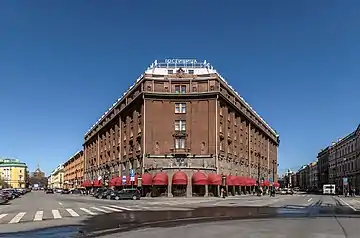
Hotel Astoria (Russian: гости́ница «Асто́рия») is a five-star hotel in Saint Petersburg, Russia, that first opened in December 1912. It has 213 bedrooms, including 52 suites, and is located on Saint Isaac's Square, next to Saint Isaac's Cathedral and across from the historic Imperial German Embassy. Hotel Astoria, along with its neighboring sister hotel, Angleterre Hotel, is owned and managed by Rocco Forte Hotels. The hotel underwent a complete refurbishment in 2012. (Full article...) Image 9
Image 9
The MGM Grand fire occurred on Friday, November 21, 1980 at the MGM Grand Hotel and Casino (now Horseshoe Las Vegas), located on the Las Vegas Strip in Paradise, Nevada. The fire killed 85 people, most through smoke inhalation. The fire began from a refrigerated pastry display case in one of the restaurants, located on the first floor. Fire engulfed the resort's casino, and smoke travelled into the hotel tower.
The tragedy remains the deadliest disaster in Nevada history, and the third-deadliest hotel fire in modern U.S. history, after the 1946 Winecoff Hotel fire in Atlanta that killed 119 people and the 1986 Dupont Plaza Hotel fire in Puerto Rico that killed 97. The incident led to the reformation of fire safety guidelines and codes in the state. (Full article...) Image 10
Image 10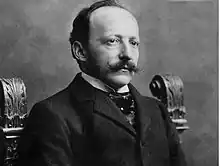 Portrait of César Ritz
Portrait of César Ritz
César Ritz, born Cäsar Ritz (23 February 1850 – 24 October 1918), was a Swiss hotelier and founder of several hotels, most famously the Hôtel Ritz in Paris and the Ritz and Carlton Hotels in London (the forerunners of the modern Ritz-Carlton Hotel Company). He was an early hotel chain founder known as "King of Hoteliers, and Hotelier to Kings," and it is from his name and that of his hotels that the term ritzy derives. (Full article...) Image 11
Image 11 The former Astor Hotel in 2011
The former Astor Hotel in 2011
The John Jacob Astor Hotel, originally known as the Hotel Astoria, is a historic former hotel building located in Astoria, Oregon, United States, and listed on the National Register of Historic Places (NRHP). It is one of the tallest buildings on the Oregon Coast and is a "prominent landmark" in Astoria. Constructed in 1922–23, the hotel opened in 1924 and initially was the city's social and business hub, but soon was beset with a variety of problems, and struggled financially for years. It was renamed the John Jacob Astor Hotel in 1951, but a decline in business continued, as did other problems. The building was condemned by the city for safety violations in 1968 and sat vacant for several years until 1984, when work to renovate it and convert it for apartments began. It reopened as an apartment building in 1986, with the lowermost two floors reserved for commercial use. The building was listed on the NRHP in 1979. The world's first cable television system was set up in 1948 using an antenna on the roof of the Hotel Astoria. (Full article...) Image 12
Image 12 Pisani, August 2005
Pisani, August 2005
Alfred Pisani (born 1939) is a Maltese businessman and hotelier, among the founders of the Corinthia Group of Companies, and its chairman and chief executive since the company's inception in 1966. (Full article...) Image 13
Image 13 The Balsams Grand Resort Hotel in Dixville Notch
The Balsams Grand Resort Hotel in Dixville Notch
The Balsams Grand Resort Hotel is a grand hotel and ski resort located in Dixville Notch in New Hampshire, United States. It has been closed since 2011. The resort grounds cover 11,000 acres (45 km2) and feature 95 km (59 mi) of cross-country ski trails, an alpine ski area with 16 trails, five glade areas and a terrain park. There is also a nine-hole golf course and an 18-hole championship course called "Panorama" which was designed by Donald Ross. (Full article...) Image 14
Image 14
Radisson Blu Plaza Hotel, Oslo, formerly Radisson SAS Plaza Hotel, Oslo, known locally as Oslo Plaza, is situated in Oslo city centre. At 117 metres (384 ft) tall, it is Norway's second tallest building.
The building was designed by the architectural firm White.se and completed in 1989. The hotel was officially opened on 14 March 1990, by King Olav V of Norway. In 1992, a footbridge was built between the hotel and the Oslo Spektrum arena. The hotel was remodeled in 2012.
The hotel has 37 floors and 678 rooms. There are a total of 1,500 beds, 140 business rooms and 20 suites. The tower's foundations are concrete, and it has reflective glass facades. The uppermost floors are tapered with a steep diagonal roof on one side, leading to a sharp ridge. It also has an external glass elevator, which travels up to the bar/restaurant at the top. A lower block, three floors tall, contains the entrance, a lobby, restaurants and conference rooms. (Full article...) Image 15
Image 15 (1917)
(1917)
The New York Biltmore Hotel was a luxury hotel at 335 Madison Avenue in Midtown Manhattan, New York City. The hotel was developed by the New York Central Railroad and the New York, New Haven and Hartford Railroad and operated from 1913 to 1981. It was one of several large hotels developed around Grand Central Terminal as part of Terminal City. The Biltmore was designed in the Italian Renaissance Revival style by Warren and Wetmore, one of the firms involved in designing Grand Central. Although the hotel's steel frame still exists, the hotel itself was almost entirely demolished and replaced by an office building in the early 1980s.
The hotel building was variously cited as having between 23 and 26 stories. The hotel had a facade of granite, limestone, brick, and terracotta. Most of its floor plan was U-shaped, with a light court facing west toward Madison Avenue. In the basement was a reception room that led directly from Grand Central Terminal. The public dining rooms, including the Palm Court and main dining room, were at ground level. There was a roof garden above the sixth story, facing east toward Vanderbilt Avenue. There were additional ballrooms and meeting spaces on the upper stories. In total, the Biltmore had 1,000 rooms and suites; the fourth floor included a private entertainment suite called the Presidential Suite.
Following the construction of Grand Central Terminal, the New York Central started planning a hotel on the city block in the early 1910s, and it officially opened on December 31, 1913. The hotel was originally operated by Gustav Baumann, who died in October 1914. The hotel's manager, John McEntee Bowman, then operated it until his own death in 1931, affiliating the Biltmore with the Bowman-Biltmore Hotels chain. Realty Hotels Inc., a subsidiary of the New York Central, took over the hotel in 1934 and operated it for four decades. Paul Milstein acquired the hotel in 1978 and began demolishing the interiors immediately after the hotel closed on August 15, 1981. Despite protests from preservationists, Milstein gutted the Biltmore and converted it into an office building called Bank of America Plaza, which reopened in May 1984. Bank of America relocated in 2010 and the building became 335 Madison Avenue. Following another renovation in 2019, the structure became The Company Building, which in turn was renamed 22 Vanderbilt in late 2022. (Full article...)
Did you know (auto-generated)
- ... that when the former Clarence Hotel in Brighton began to collapse in 1990, the resulting closure of North Street diverted 120 buses per hour in each direction for a week?
- ... that originally, residents of New York City's Ansonia Hotel received fresh eggs from a farm on its roof?
- ... that after a guest smuggled a lion into the Hotel Belleclaire using a piano crate, the lion was thrown out of the hotel?
- ... that John Lennon and Yoko Ono recorded Ono's song "Remember Love" in a Montreal hotel room that has been a tourist draw ever since?
- ... that The Mutiny Hotel was described as a haven for "cocaine cowboys"?
- ... that the New Yorker Hotel once had the largest private power plant in the United States?
- ... that New York City's Hotel Knickerbocker closed after fourteen years of operation and did not reopen for nearly a century?
- ... that Danny Kaleikini once worked as a singing hotel busboy in Waikiki before becoming the headline entertainer at the Kahala Hilton for 28 years?
Related portals
WikiProjects
![]()
- WikiProject Travel and Tourism
- WikiProject Companies
- WikiProject Hotels (inactive)
List articles
- Historic Hotels of America
- List of largest hotels
- List of largest hotels in Europe
- List of tallest hotels
- List of casino hotels
- List of chained-brand hotels
- List of defunct hotel chains
- List of hotels in the Caribbean
- List of caravanserais
- Lists of hotels
- List of motels
- Lists of hotels by country (category page)
- Lists of hotels by city (category page)
Topics
|
| ||||||||||||||||||||||||||||||||||||||||||||||||||||||||||||||||||||||||||||||||||||||||||||||||||||||||||||||||||||||||||||||||||||||||||||||||||||||||||||||||||||||||||||||||||||||||||||||||||||||||||||||||||||||||||||||||||||||||||||||||||||||||||||||||||||
Categories
Associated Wikimedia
The following Wikimedia Foundation sister projects provide more on this subject:
-
 Commons
Commons
Free media repository -
 Wikibooks
Wikibooks
Free textbooks and manuals -
 Wikidata
Wikidata
Free knowledge base -
 Wikinews
Wikinews
Free-content news -
 Wikiquote
Wikiquote
Collection of quotations -
 Wikisource
Wikisource
Free-content library -
 Wikiversity
Wikiversity
Free learning tools -
 Wiktionary
Wiktionary
Dictionary and thesaurus
More portals
-
 List of all portals
List of all portals -

-

-

-

-

-

-

-

-

-
 Random portal
Random portal -
 WikiProject Portals
WikiProject Portals